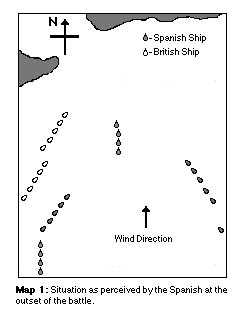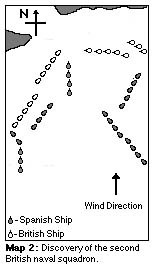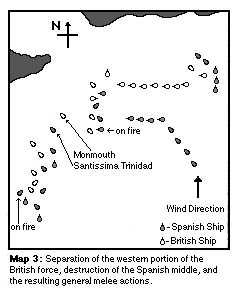
Campaign Overview
This game was fought as part of a Napoleonic Strategic campaign, primarily involving Dayton area members of HMGS Great Lakes. Players direct the political and military activities of a single nation, with each month being a campaign turn. The political aspect is based on nations participating in opposing factions -- either Pro-French or Anti-French. Alternately, nations may elect to avoid war by joining neither and remaining neutral.
Forces are moved in army division and naval squadron sized units across a 100-mile hex grid map of Europe. The campaign began in July 1805, with France, Spain, Bavaria, and Holland allied (the Pro-French faction) against the forces of Great Britain, Russia, Austria, and Portugal (the Anti-French faction). The conflict started in August as Austria invaded Italy, attempting to reclaim the region it had lost to Napoleon and France in 1800. This forced Italy to join the Pro-French faction and a battle between a combined French/Italian army and the Austrian invaders is about to be fought (a report of this, the Battle of Milan, will be forwarded after the action is resolved).
At the start of the conflict, Britain already had a tight blockade of all French naval units. This blockade placed a single squadron of British ships at the mouth of the port of Marseilles bottling up the two French squadrons located there. The Spanish fleet sailed from eastern Spain with three squadrons of ships to attempt to break the blockade and allow Spain and France to have free access to the Mediterranean.
The Battle
 The Battle of Marseilles started with the Spanish admiral confident of victory. His intelligence reports stated that 10 British ships were blockading Marseilles, and he was certain that his force of 26 ships would
quickly dispatch the enemy force. The mouth of the port was guarded by two
French batteries, indicated on the map. More concerned with the British ships escaping than actually having to fight them, he deployed in three major groups to ensure that the British fleet could not escape to the east (see map 1).
The Battle of Marseilles started with the Spanish admiral confident of victory. His intelligence reports stated that 10 British ships were blockading Marseilles, and he was certain that his force of 26 ships would
quickly dispatch the enemy force. The mouth of the port was guarded by two
French batteries, indicated on the map. More concerned with the British ships escaping than actually having to fight them, he deployed in three major groups to ensure that the British fleet could not escape to the east (see map 1).
As soon as the action was joined, the Spanish fleet sighted an additional force of British ships (see map 2). Due to the British Admiralty's anticipation of the Spanish movements, ten more ships had been added to the blockading force from Sicily only days prior to the battle. Suddenly, the Spanish admiral realized he had a real fight on his hands. The middle force of four Spanish ships was caught between two converging British forces, resulting in two Spanish with wrecked hulls and another on fire. In return, one British ship lost 2/3's and another significant portions of its rigging (see Map 3).
In the east, the vanguard of the Spanish force turned eastward to loop behind the closing British squadron, while the middle and rear of the force broke off to follow a parallel course, engaging at long range (see Map 3).This allowed the Spanish to cripple two ships in the rear of the British squadron with very little damage to themselves. The Spanish ships that formed up to exchange broadsides with the British in the east did not fare as well, suffering significant damage while inflicting only scratches. Also, their new course led them directly into the confused melee in the center.
In the west, the remaining five British ships had their hands full dealing with eight Spanish ships(see Map 3). The Spaniards were led by the mighty 130-gun Santissima Trinadad which paired off in combat against the Monmouth, a lowly 64-gun ship broken off from the melee in the center. Although an excellent matchup for the Santissima, the Monmouth stood her ground under the withering fire and significantly eased pressure on the ships engaged in the general melee in the west. This melee resulted in one Spanish three-decker catching fire, and several ships engaging in boarding actions which generally went in the favor of the British.

The Results
The engagement ended with the British unable to maintain its blockade, slipping out past the disordered Spanish force to the west along the coast. The Spanish, having achieved their goal of breaking the blockade achieved a victory, but at a cost.
The results for the British were two ships wrecked outright, and two more were scuttled by their crews when unable to escape. In addition, three more escaped but were so badly damaged (mostly rigging and masts) that they had to be sent home for major repairs. Six ships escaped the battle untouched, despite their being heavily engaged! These were instrumental in ensuring that the remnants of the British fleet were able to escape. (Campaign result was one British squadron lost, and the remaining squadron withdrew to the west of Marseilles.)
For the Spanish, the results were two ships wrecked (including a 112-gun three-decker), one captured (but too heavily damaged to be repaired easily), two significantly damaged by fire, and one able to make it into the shallow waters of the port before taking on enough water to sink. The crew losses in the Spanish fleet were very high which may cause problems for the Spanish later since they do not have a large pool of competent seamen. There were eleven Spanish ships that were untouched, most of which were involved in the eastern fight. Four were from the unengaged rear of the eastern force. (Campaign result was one Spanish squadron lost, two remain at Marseilles, and the blockade was broken.)
Game Master's Comments
I was very pleased by the turnout for the game. I had enough forces to allow 10 players to participate if attendance was good. We ended up with eight. The rules used were Avalon Hill's "Wooden Ships and Iron Men" (WSIM). Although several of the players had never played WSIM and the gamemaster had not played in more than 10 years, it went very smoothly and fairly quickly. Each turn in the game represents three minutes of battle, and we completed 12 turns in under three hours, which was much better than I had expected. I think that a 46-ship battle was a lot to hope for in a single evening of gaming, but I was pleased that a clear outcome seemed to have been achieved. A more conclusive outcome would have resulted if we had been able to complete another three turns or so.
Post-game comments generally showed that five ships per person is not too much to handle. The game charts were simple enough for people to handle quickly, though some more experience would probably speed up the game. The addition of a few rules by the game master to increase fleet disorder and allow for ships to catch fire when shot at did not seem to detract from the game and added some additional "flavor" to the play. Overall, WSIM rules provided an excellent game.
The miniatures used were 1/2000 scale ships from Valiant Miniatures. When assembled, the ships easily fit on a 2" x 3/4" base, and they work well withthe WSIM rules if a 1 1/2" hex map is used. Although Valiant Miniatures are not widely available, they can be ordered from a shop I found on the internet called The Last Square (www.fullfeed.com/~tl2/index2.html), or phone (800) 750-4401. The ships come three to a pack for $7.95, including separate cast sails, and a painting and flag guide. Smaller frigates and other small ships come four to a pack. I have had great luck ordering from The Last Square -- all three times my orders have been filled completely and delivered within three days. They also provide a 10% discount to HMGS members, so be sure that they know you are a member!
Back to The Herald 23 Table of Contents
Back to The Herald List of Issues
Back to MagWeb Master Magazine List
© Copyright 1998 by HMGS-GL.
This article appears in MagWeb.com (Magazine Web) on the Internet World Wide Web. Other articles from military history and related magazines are available at http://www.magweb.com